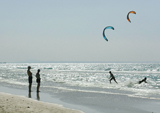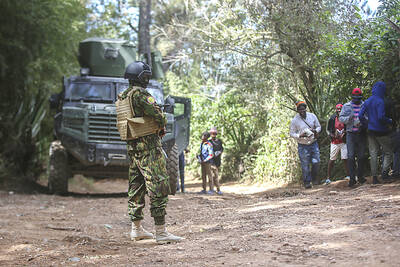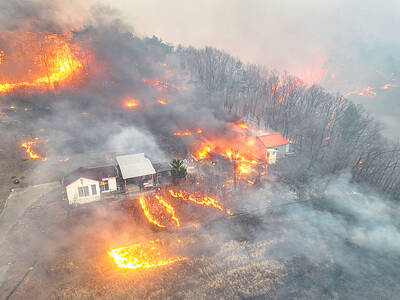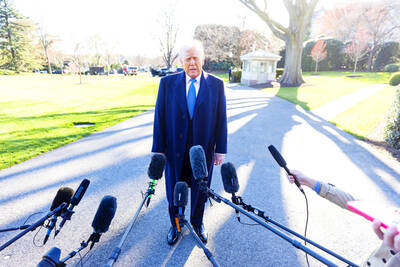Behind the mangroves that skirt the blue waters of Cuba’s Bay of Cardenas, a 1,500-slip marina is taking shape as the island’s tourism industry braces for what could be its biggest challenge yet.
The Americans are coming — or they may be, soon.
Rock jetties jut out into the bay and beyond them a plot of land the size of several football fields is taking shape, reclaimed from the water as part of a big new marina project at Varadero, a beach resort 130km east of Havana.

PHOTO: REUTERS
“The Americans will come here in their yachts and they’ll put them in the marina,” said a security guard, gesturing to the earth-moving and sand-dredging behind the mangroves.
For most of the time since former Cuban president Fidel Castro’s 1959 revolution, Americans have been prohibited by their own laws from traveling to the Caribbean island under a 47-year-old US trade embargo.
But that may change. Legislation to free travel by Americans to Cuba is pending in the US Congress, and backers expect it could be approved in what they see as a developing thaw in US-Cuba relations under US President Barack Obama.
“If the travel ban is lifted, you’ll probably see hundreds, hundreds of American yachtsmen going to Cuba the next day,” said Timothy Ashby, a former US Commerce Department official who studies Cuban commercial issues.
Cuba’s government and people have been anticipating this moment for a long time, but questions about their readiness for an onslaught of visitors are being raised.
The doubts focus on the capacity and quality of Cuba’s tourist infrastructure, but also on possible political effects on an island that has resisted US influence for 50 years.
After years of animosity with the US, Cuban leaders do not like to say that developments such as the Varadero marina, and other big golf and leisure projects, are being built with the US market in mind.
The official line is that Cuba is preparing for visitors from the whole world and if that includes Americans, so be it.
But the US is the natural market for Cuba, whose economy is reeling from the damage inflicted by three hurricanes last year and the ongoing global financial crisis.
A study for the IMF estimated that as many as 3.5 million Americans could visit Cuba annually if the travel ban was lifted.
But travel experts say 500,000 is a more likely maximum the Cuban government would allow in the early years because it does not have enough facilities for more.
“Cuba is ready to absorb another half million visitors a year, but not another million, just because of hotel capacity,” said a foreign businessman in Cuba’s travel industry.
“I’m sure they will try to control as much as they can in order to avoid a boom that nobody can control. Every country in the world would try to do the same,” he said.
One of Cuba’s biggest sources of cash in recent years has been foreign tourism, which brought in US$2.5 billion in revenues last year.
Government statistics show Cuba had about 55,000 hotel rooms in 2007, the last year for which figures are available. At least 10,000 more are under construction, and others are on the drawing boards.
Experts say Cuba will need more four and five-star hotels for Americans, but also more and better restaurants, shops, rental cars and other tourist amenities.
Before Castro took power on Jan. 1, 1959, in a guerrilla uprising, Cuba was a US playground where Americans swilled booze during Prohibition and gambled and partied the night away in Mafia-built casinos and nightclubs in the 1950s.
Opponents of the Cuba embargo hope more visitors could open up future opportunities for US investors in a Cuban market now dominated by Europeans and Canadians.
Because of its proximity, travel experts say it is inevitable the US will one day dominate Cuba tourism again. Within 10 years, said one industry source, perhaps 70 percent of the island’s visitors will be American or Canadian.
When that happens, said Nigel Hunt, head of Cubaism Ltd, an Internet travel sales site, Europeans who make up about 40 percent of Cuba tourists may go elsewhere.
“If Cuba becomes Americanized, it would probably be less attractive to Europeans ... That’s what makes Cuba interesting, modern American culture is not so pervasive here,” he said.
The possible “Americanization” of Cuba is a selling point in Washington for lifting the travel ban. Supporters say the more Americans who visit the island, the more pressure there will be for an economic and political opening on the island.
While Cuba’s leaders may fret over the prospect of large numbers of Americans arriving, ordinary people in Varadero who depend on tourism for a living seem much less worried.
“Not one person here has anything against the Americans,” said hotel cook and taxi driver Jorge Mendives.
“Let them come to Varadero in their boats or whatever because for us the Americans mean one thing — more money.”

DEATH CONSTANTLY LOOMING: Decades of detention took a major toll on Iwao Hakamada’s mental health, his lawyers describing him as ‘living in a world of fantasy’ A Japanese man wrongly convicted of murder who was the world’s longest-serving death row inmate has been awarded US$1.44 million in compensation, an official said yesterday. The payout represents ¥12,500 (US$83) for each day of the more than four decades that Iwao Hakamada spent in detention, most of it on death row when each day could have been his last. It is a record for compensation of this kind, Japanese media said. The former boxer, now 89, was exonerated last year of a 1966 quadruple murder after a tireless campaign by his sister and others. The case sparked scrutiny of the justice system in

DITCH TACTICS: Kenyan officers were on their way to rescue Haitian police stuck in a ditch suspected to have been deliberately dug by Haitian gang members A Kenyan policeman deployed in Haiti has gone missing after violent gangs attacked a group of officers on a rescue mission, a UN-backed multinational security mission said in a statement yesterday. The Kenyan officers on Tuesday were on their way to rescue Haitian police stuck in a ditch “suspected to have been deliberately dug by gangs,” the statement said, adding that “specialized teams have been deployed” to search for the missing officer. Local media outlets in Haiti reported that the officer had been killed and videos of a lifeless man clothed in Kenyan uniform were shared on social media. Gang violence has left

‘HUMAN NEGLIGENCE’: The fire is believed to have been caused by someone who was visiting an ancestral grave and accidentally started the blaze, the acting president said Deadly wildfires in South Korea worsened overnight, officials said yesterday, as dry, windy weather hampered efforts to contain one of the nation’s worst-ever fire outbreaks. More than a dozen different blazes broke out over the weekend, with Acting South Korean Interior and Safety Minister Ko Ki-dong reporting thousands of hectares burned and four people killed. “The wildfires have so far affected about 14,694 hectares, with damage continuing to grow,” Ko said. The extent of damage would make the fires collectively the third-largest in South Korea’s history. The largest was an April 2000 blaze that scorched 23,913 hectares across the east coast. More than 3,000

‘INCREDIBLY TROUBLESOME’: Hours after a judge questioned the legality of invoking a wartime power to deport immigrants, the president denied signing the proclamation The US on Friday said it was terminating the legal status of hundreds of thousands of immigrants, giving them weeks to leave the country. US President Donald Trump has pledged to carry out the largest deportation campaign in US history and curb immigration, mainly from Latin American nations. The order affects about 532,000 Cubans, Haitians, Nicaraguans and Venezuelans who came to the US under a scheme launched in October 2022 by Trump’s predecessor, Joe Biden, and expanded in January the following year. They would lose their legal protection 30 days after the US Department of Homeland Security’s order is published in the Federal